Jharkhand
This article possibly contains original research. (May 2017) (Learn how and when to remove this template message)
|
| Jharkhand | ||
|---|---|---|
| State of India | ||

An immensely resource-rich state, Jharkhand suffers from resource curse
| ||
| ||
 Location of Jharkhand | ||
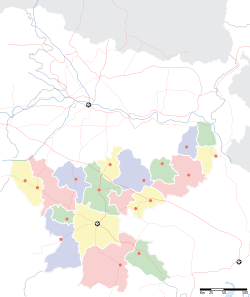 Map of Jharkhand | ||
| Coordinates (Ranchi): 23.35°N 85.33°ECoordinates: 23.35°N 85.33°E | ||
| Country | India | |
| Region | East India | |
| Formation | 15 November 2000 | |
| Capital | Ranchi | |
| Largest city | Jamshedpur | |
| Districts | 24 | |
| Government | ||
| • Governor | Draupadi Murmu | |
| • Chief Minister | Raghubar Das (BJP) | |
| • Legislature | Unicameral (81 seats) | |
| • Parliamentary constituency | 14 | |
| • High Court | Jharkhand High Court | |
| Area | ||
| • Total | 79,714 km2(30,778 sq mi) | |
| Area rank | 16th | |
| Population (2011)[1] | ||
| • Total | 32,988,134 | |
| • Rank | 14th | |
| • Density | 414/km2(1,070/sq mi) | |
| Time zone | IST (UTC+05:30) | |
| ISO 3166 code | IN-JH | |
| HDI | ||
| HDI rank | 19th (2007-08) | |
| Literacy | 67.6% (31th) | |
| Official language[2] | Hindi | |
| Website | www | |
| †Formed by the Bihar Reorganisation Act, 2000 | ||
Jharkhand (lit. "Bushland" or The land of forest) is a state in eastern India, carved out of the southern part of Bihar on 15 November 2000.[3] The state shares its border with the states of Bihar to the north, Uttar Pradesh to the northwest, Chhattisgarh to the west, Odisha to the south, and West Bengal to the east. It has an area of 79,710 km2 (30,778 sq mi).
Jharkhand suffers from resource curse;[4] It accounts for more than 40% of the mineral resources of India,[5] but it suffers widespread poverty as 39.1 per cent of the population is below the poverty line and 19.6 per cent of the children under five years of age are malnourished.[6] The State is primarily a rural state as only 24 percent of the population resides in cities.[7]
Contents
[hide]History
According to writers including Gautam Kumar Bera,[8] there was already a distinct geo-political, cultural entity called Jharkhand even before the Magadha Empire. Bera's book (page 33) also refers to the Hindu epic Bhavishya Purana. The tribal rulers, some of whom continue to thrive till today were known as the Munda Rajas,[9][10] who basically had ownership rights to large farmlands.[11] During the age of Mahajanpadas around 500 BC, India saw the emergence of 16 large states that controlled the entire Indian subcontinent. In those days the Jharkhand state was a part of Magadha, Anga, Banga, Kalinga, Kashi and Vajji.
British rule
In 1765, the region came under the control of the British East India Company. The subjugation and colonisation of Jharkhand region by the British East India Company resulted in spontaneous resistance from the local people. Almost one hundred years before Indian Rebellion of 1857, Adivasis of Jharkhand were already beginning what would become a series of repeated revolts against British colonial rule:
The period of revolts of the Adivasis to protect their Jharkhand land took place from 1771 to 1900. The first ever revolt against the landlords and the British government was led by Tilka Manjhi, a Paharia leader in Rajmahal Hills in 1771. He wanted to liberate his people from the clutches of the unscrupulous landlords and restore the lands of their ancestors. The British government sent its troops and crushed the uprisings of Tilka Manjhi. Soon after in 1779, the Bhumij tribes rose in arms against the British rule in Manbhum, now in West Bengal. This was followed by the Chero tribes unrest in Palamau.
They revolted against the British rule in 1800 AD. Hardly seven years later in 1807, the Oraons in Barway murdered their big landlord from Srinagar, west of Gumla. Soon the uprisings spread around Gumla. The tribal uprisings spread eastward to neighbouring Tamar areas of the Munda tribes. They too rose in revolt in 1811 and 1813. The Hos in Singhbhum were growing restless and came out in open revolt in 1820 and fought against the landlords and the British troops for two years. This is called the Lakra Kol Risings 1820–1821. Then came the great Kol Risings of 1832. This was the first biggest tribal revolt that greatly upset the British administration in Jharkhand. It was caused by an attempt by the Zamindars to oust the tribal peasants from their hereditary possessions. The Santhal rebellion broke out in 1855 under the leadership of two brothers Sidhu and Kanhu.
Then Birsa Munda revolt,[12] broke out in 1895 and lasted till 1900. The revolt though mainly concentrated in the Munda belt of Khunti, Tamar, Sarwada and Bandgaon, pulled its supporters from Oraon belt of Lohardaga, Sisai and even Barway. It was the longest and the greatest tribal revolt.[13][not in citation given]
Post-independence
After the last Assembly election in the state threw up a hung Assembly, RJD's dependence on the Congress extended support on the precondition that RJD will not pose a hurdle to the passage of the Bihar reorganization Bill (Jharkhand Bill). Finally, with the support from both RJD and Congress, the ruling coalition at the Centre led by the BJP which has made statehood its mail poll plank in the region in successive polls earlier, cleared the Jharkhand Bill in the monsoon session of the Parliament this year, thus paving the way for the creation of a separate Jharkhand state.[14]
Jharkhand statehood
The dynamics of resources and the politics of development still influence the socio-economic structures in Jharkhand, which was carved out of the relatively under developed southern part of Bihar. According to the 1991 census, the state has a population of over 20 million out of which 28% is tribal while 12% of the people belong to scheduled castes. Jharkhand has 24 districts, 260 blocks and 32,620 villages out of which only 45% have access to electricity while only 8,484 are connected by roads. Jharkhand is the leading producer of mineral wealth in the country after Chhattisgarh state, endowed as it is with vast variety of minerals like iron ore, coal, copper ore, mica, bauxite, graphite, limestone, and uranium. Jharkhand is also known for its vast forest resources.[15]
Naxal insurgency
Jharkhand has been at the centre of the Naxalite-Maoist insurgency. Since the uprising of the Naxalites in 1967, 6,000 people have been killed in fighting between the Naxalites and counter-insurgency operations by the police, and its paramilitary groups such as the Salwa Judum.[16]
Despite having a presence in almost 7.80% of India's geographical area[17] (home to 5.50% of India's population), the state of Jharkhand is part of the "Naxal Belt" comprising 92,000 square kilometres,[17] where the highest concentrations of the groups estimated 20,000 combatants[18] fight. Part of this is due to the fact that the state harbours a rich abundance of natural resources, while its people live in abject poverty and destitution.[19] The impoverished state provides ample recruits for the communist insurgents, who argue that they are fighting on behalf of the landless poor that see few benefits from the resource extractions.[19] As the federal government holds a monopoly on sub-surface resources in the state, the tribal population is prevented from staking any claim on the resources extracted from their land.[19] In response, the insurgents have recently begun a campaign of targeting infrastructure related to the extraction of resources vital for Indian energy needs, such as coal.[17]
On 5 March 2007, Sunil Mahato, a member of the national parliament, was shot dead by Naxalite rebels near Kishanpur while watching a football match on the Hindu festival ofHoli. His widow, Suman Mahato, the Jharkhand Mukti Morcha candidate, won the Jamshedpur Lok Sabha by-election in September 2007 and served in parliament until 2009.[20]
Geography
| Formation day | 15 November 2000 Created by "Bihar Reorganisation Act, 2000." | |
| State animal | Elephant[21] | |
| State bird | Koel |  |
| State tree | Sal[21] | |
| State flower | Palash[21] |
Jharkhand is located in the eastern part of India and is enclosed by Bihar to the northern side, Chhattisgarh and Uttar Pradesh to the western side, Odisha to the southern part and West Bengal to the eastern part.
Jharkhand envelops a geographical area of 79.70 lakh hectare. A lot many areas of Jharkhand lie on Chota Nagpur Plateau. Many rivers pass through the Chota Nagpur plateau. They are: Damodar, Brahmani, Koel, Subarnarekha and Kharkairivers. The higher watersheds of these rivers stretch out within the Jharkhand state. Much of the Jharkhand state is still enclosed by forest. Forests sustain the population of Elephants and tigers.
Hills and Mountain Ranges
- Tagore Hill: The Tagore Hill is also recognized as the Morabadi Hill. The Tagore hill is located in Morabadi, Ranchi. The Tagore Hill stands like a guard on the top of a hill. The brother of Rabindranath Tagore, Jyotirindranath Tagore had made a tour at Ranchi in the year 1908. He was enamored by the appeal of the mesmerizing place.
- Canary Hill: Canary Hill is surrounded by beautiful parks and is studded with 3 tiny lakes. Canary hill has a surveillance tower. From the hill’s top, a panoramic sight of the township can be observed. The finest place to drench in the natural beauty of Hazaribagh is from the Canary Hill which pays off for the beautiful view of the dense flora in its ambiance.
- Parasnath Hill: Parasnath Hill is also recognized as Sri Sammed Sikharji. The Parasnath Hill is situated in Giridih district of Jharkhand. It is a chief Jain pilgrimage site and the holy place for Jains. It is believed in the Jain culture that 20 of the 24 Tirthankaras attained Moksha from this place. The height of the hill is 1,350 meters.
- Fuldungri: Fuldungri is situated on a small hill near Ghatshila town. Fuldungri’s peak proffers a panoramic sight of the undulating hills and valleys. The gorgeous Burudih Lake is situated seventeen kilometers North of Fuldungri. It is yet another nearby attraction.
- Trikut Hill: Trikut Hill is located ten kilometers away from Deoghar and lies on the way to Dumka in Jharkhand. Trikut hill is also called Trikutchal because there are 3 major peaks on the hill. The height of Trikut hill is 2470 feet.
- Nandan Hill: Nandan hill is a small hill binding the township which has a well-known Nandi Temple. The Nandi hill has been brilliantly maintained by the local government. It speaks a lot about the attractiveness of the place. The Nandan hill is located in front of the well-known Shiv temple. It is also surrounded by beautiful lake tempting the tourists.
- Ranchi Hill: The Ranchi Hill is one of the preferred sightseer attractions in Ranchi, Jharkhand. At Ranchi Hill’s pinnacle, there is a holy place dedicated to Lord Shiva. Ranchi hill magnetize tourists to have a panoramic sight of the place. At the pedestal of the hill of Ranchi there is a lake, Ranchi Lake.
Main Rivers
- Sone River: Origin of Sone River: Amarkantak, Cities on the Shore of Sone River: Sidhi, Dehri, Patna
- Subarnarekha River: Origin of Subarnarekha River: Chota Nagpur Plateau, Cities on the Shore of Subarnarekha River: Chandil, Jamshedpur, Ghatshila, Gopiballavpur
- Damodar River: Origin of Damodar River: Chota Nagpur Plateau, Cities on the Shore of Damodar River: Bokaro, Asansol, Raniganj, Durgapur, Bardhaman
- South Koyal River: Origin of South Koyal River: Chota Nagpur Plateau, Cities on the Shore of South Koyal River: Manoharpur
- Ajay River: Origin of Ajay River: Munger, Cities on the Shore of Ajay River: Churulia, Chittaranjan, Ilambazar, Jaydev Kenduli
- Phalgu River: Origin of Phalgu River: Northern Chota Nagpur Plateau, City on the Shore of Phalgu River: Gaya
- Mayurakshi River: Origin of Mayurakshi River: Trikut hill, City on the Shore of Mayurakshi River: Suri
Flora and Fauna
Jharkhand has a rich variety of flora and fauna. The National Parks and the Zoological Gardens located in the state of Jharkhand present a panorama of this variety.
Part of the reason for the variety and diversity of flora and fauna found in Jharkhand state may be accredited to the Palamau Tiger Reserves under the Project Tiger. This reserve is abode to hundreds of species of flora and fauna,[22] as indicated within brackets: mammals (39), snakes (8), lizards (4), fish (6), insects (21), birds (170), seed bearing plants and trees (97), shrubs and herbs (46), climbers, parasites and semi-parasites (25), and grasses and bamboos (17).
Demographics
As per 2011 Indian Census Jharkhand has a population of 32.96 million, consisting of 16.93 million males and 16.03 million females.[23]The sex ratio is 947 females to 1000 males.[23] The literacy rate of the state was 67.63% with Ranchi district being most educated at 77.13% compared to rural Pakur district being least at 50.17%.[23]
| [show]Population Growth |
|---|
Language
Hindi is the official language in Jharkhand and Urdu has been declared as an additional official language.[25]Jharkhand legislature had passed a bill according the status of a second official language to several languages in 2011 but the same was turned down by the Governor.[26][27][28] As per the 2001 census, major languages spoken in Jharkhand (with 2001 census percentages in brackets): Hindi (57.56%),Santali (10.69%), Bengali (9.68%), Urdu (8.63%), Kurukh (3.20%), Mundari (3.19%), Ho (2.90%) and Odia (1.74%).[29]
Religion
As per the 2011 census, Hinduism is the majority religion in the state at 67.8%, followed by Islam at 14.5% and Christianity at 4.3%.[30] Other religions, primarily Sarnaism, constitute 12.8% of the population.[31]
Cuisine
Jharkhandis have a cuisine in which spices are rarely used and rice is the staple diet. They prepare different dishes of rice, different types of Rotis, Litti Chokha, Pani puri (Gupchup), Pittha, Dhuska, Dudhauri, kera-dudhauri, Jhalmudhi etc. Dhuska is a famous dish of Jharkhand cooked with mashed rice and pulses and served with either aaloo dum or mutton curry; kera-dudhauri is a famous dish prepared with milk, rice, ghee and gur. In many parts of Jharkhand including Panch Pargana area (Bundu, Rahe, Sonahatu, Silli, Angara, Arki and Tamar Blocks of Ranchi & Khunti districts) a special food item "Charpa" is prepared by frying mashed rice mixed with spicy vegetable preparations; hence the name follows viz. Sembi Charpa, Egg Charpa and many more depending upon the ingredient vegetable source.[32][33]
Local alcoholic drinks include rice beer, originally known as Diyeng or Handia, named after the vessel (earthen pot) used to make it. Handiya is culturally associated with native i.e. Tribals as well as Sadan, as this drink is consumed by both men and women, on social occasions like marriage and other festivals.[34][35] Another common liquor is called Mahu, made from fruit/flowers of the "Mahua" tree (Madhukam Indicum).[36]
Administrative districts
The state was formed with 18 districts that were formerly part of south Bihar. Some of these districts were reorganised to form 6 new districts, namely, Latehar, Saraikela Kharsawan, Jamtara, Sahebganj, Khunti and Ramgarh. At present, the state has 5 Divisions and 24 Districts. One interesting thing about Jharkhand is that all its districts, except Lohardaga and Khunti, share a border with a neighboring state.[37]
Divisions and districts
Major cities
| Largest Cities in Jharkhand (2011 Census of India estimate)[38] | |||||||||||
|---|---|---|---|---|---|---|---|---|---|---|---|
| Rank | City | District | Population | Rank | City | District | Population | ||||
| 01 | Jamshedpur | East Singbhum | 1,339,438 | 06 | Phusro | Bokaro | 185,555 | ||||
| 02 | Dhanbad | Dhanbad | 1,196,214 | 07 | Hazaribagh | Hazaribagh | 153,595 | ||||
| 03 | Ranchi | Ranchi | 1,120,374 | 08 | Giridih | Giridh | 143,630 | ||||
| 04 | Bokaro Steel City | Bokaro | 564,319 | 09 | Ramgarh | Ramgarh | 132,425 | ||||
| 05 | Deoghar | Deoghar | 203,123 | 10 | Daltonganj | Palamu | 120,325 | ||||
Economy
Jharkhand has several towns and innumerable villages with civic amenities. Urbanization ratio is 24.1% and the per capita annual income is US$726.8.[39] Jharkhand also has immense mineral resources: minerals ranging from (ranking in the country within bracket) from iron ore(1st), coal(3rd), copper ore (1st), mica (1st), bauxite (3rd), Manganese, limestone, china clay, fire clay, graphite (8th), kainite (1st),chromite (2nd), asbestos (1st), thorium (3rd), sillimanite, uranium (Jaduguda mines, Narwa Pahar) (1st) and even gold (Rakha Mines) (6th) and silver and several other minerals. Large deposits of coal and iron ore support concentration of industry, in centres like Jamshedpur, Dhanbad, Bokaro and Ranchi. Tata Steel, a S&P CNX 500 conglomerate has its corporate office and main plant in Tatanagar, Jharkhand.[40] It reported a gross income of ₹. 204,910 million for 2005. NTPC will start coal production from its captive mine in state in 2011–12, for which the company will be investing about Rs 1,800 crore.[41]
Transport
Air
Ranchi Airport is the largest domestic airport in the state with air connectivity to major Indian cities of Delhi, Kolkata, Bangalore, Mumbai,Hyderabad among others.[42] Other airports present in the state are Bokaro Airport, Jamshedpur Airport, Chakulia Airport, Dumka Airport and Dhanbad Airport who mostly run private and charter flights.[43]
Roads
Jharkhand has extensive network of National Highways and State Highways.[44] There is 2,661.83 kilometres (1,653.98 mi) of paved National Highways in the state as of 2016.[44] The National highways present in the state are numbered 2, 6, 23, 31, 32, 33, 43, 75, 78, 80,98, 99, 100, 114A, 133, 133B, 133A, 143A, 220, 333, 333A, 343 and 419.[44] The Golden Quadrilateral network of Delhi – Kolkata route runs through Jharkhand notably at Dhanbad.[45][46]
Ports
Jharkhand is landlocked state but has numerous rivers and waterways.[47] A multi-model port has been planned at Sahebganj where riverGanges flows.[48] The project is estimated to cost INR 6,500 crores and phase-1 is estimated to be completed by 2019.[49]
Education
As per the 2011 census conducted by Government of India the official literacy rate for the state was 67.63% (Male: 78.45%; Female: 56.21%) with 9 districts above the average literacy rate:[50][51]
- Ranchi: 77.13% (Male: 85.53%; Female: 68.20%)
- East Singhbhum : 76.13% (Male: 84.51%; Female: 67.33%)
- Dhanbad: 75.71% (Male: 85.68%; Female: 64.70%)
- Ramgarh: 73.92% (Male: 83.51%; Female: 63.49%)
- Bokaro: 78.48% (Male: 84.50%; Female: 61.46%)
- Hazaribagh: 70.48% (Male: 81.15%; Female: 59.25%)
- Saraikela Khasawan: 68.85% (Male: 81.01%; Female: 56.19%)
- Kodarma: 68.35% (Male: 81.25%; Female: 54.77%)
- Lohardaga: 68.29% (Male: 78.62%; Female: 57.86%)
- Deoghar: 66.34% (Male: 79.13%; Female: 53.39%)
Since the formation of the new state, the Jharkhand Education Project Council (JEPC) has been implementing four projects to spread elementary education: DPEP, SSA, NPEGEL, and KGBV. The state has been moving towards the goal of universal elementary education but the target of hundred percent enrolment and retention of children in schools has not yet been attained.[52]
Jharkhand has made primary education so accessible that 95% of children of ages 6–11 are enrolled in school, as opposed to 56% in 1993–94, so this will likely to improve literacy a great deal. Some of the better known schools which operate nationally and regionally are Vikas Vidyalaya, Jawahar Navodaya Vidyalaya, DAV Hehal, St. Thomas School,Delhi Public School, Oxford Public School, De Nobili School, Kendriya Vidyalaya, Chinmaya Public School, Loyola school, Sacred Heart School, St. Xavier's, Shishu Mandir, and Surendranath Centenary School. Students from Jharkhand rank well in almost all competitive exams at the national level.[53]
Schools
The medium of instruction in schools is Hindi/English with English/Hindi/Sanskrit/Bengali/Odia as second language. After 10 years of schooling, students can join 2 years of Intermediate course (or +2 courses) in Arts, Science and Commerce. This is followed by 3 years of degree courses (graduation)or 4 years of Engineering/Agriculture/Medicinedegree. On May 2008, Jharkhand became the first in India to introduce free haircuts for poor students. 40,000 barbers will be employed with a monthly salary of 1000 rupees (25 US dollars) which will cost the state government 40 million rupees (1 million US dollars).[54]
Universities and colleges
- Birsa Agricultural University, Kanke, Ranchi
- Central University of Jharkhand, Brambe, Ranchi
- Jharkhand Rai University, Ranchi
- Kolhan University, Chaibasa
- National University of Study and Research in Law, Ranchi
- Nilamber Pitamber University, Medininagar
- Ranchi University, Ranchi
- Sido Kanhu Murmu University, Dumka
- Vinoba Bhave University, Hazaribagh
Autonomous
- Indian Institute of Information Technology, Ranchi
- Indian Institute of Management Ranchi
- Indian Institute of Technology (Indian School of Mines), Dhanbad
- National Institute of Foundry and Forge Technology (NIFFT), Ranchi
- National University of Study and Research in Law
- National Institute of Technology, Jamshedpur
- St. Xavier's College, Ranchi
- Xavier Institute of Social Service (XISS), Ranchi
- Xavier Labour Relations Institute (XLRI), Jamshedpur
Agriculture
Engineering
- Birla Institute of Technology, Mesra, Ranchi
- Birsa Institute of Technology Sindri, Dhanbad
- Cambridge Institute of Technology, Ranchi
- DAV Institute of Engineering & Technology, Daltonganj
- R.V.S College of Engineering and Technology, Jamshedpur
Management
Medical colleges
- M.G.M Medical College, Jamshedpur
- Patliputra Medical College and Hospital (PMCH), Dhanbad
- Rajendra Institute of Medical Sciences (RIMS), Ranchi
Psychiatry
Health
Because of its mild climate, Jharkhand, particularly its capital Ranchi, has been like a health resort. As far back as 1918, facilities were set up for treatment of mentally challenged.[55][not in citation given] European Mental Hospital was established along with Indian Mental Hospital. Today they are called Central Institute of Psychiatry and Ranchi Institute of Neuro-psychiatry and Allied Sciences respectively. In certain areas of Jharkhand, poverty and consequent malnutrition have given rise to diseases like tuberculosis(TB). In fact, TB has assumed epidemic proportions in certain areas of the state. For management and treatment of such TB, Itki TB Sanatorium, Ranchi, established in 1928 has been doing exemplary work as a premier institute for clinical and programmatic management of TB. The Itki TB Sanatorium is well equipped and accredited by the Indian government for quality assurance and Culture and Drug Sensitivity Testing for M.TB. It provides free of cost treatment for TB as well as Drug resistant TB. Likewise, in the field of treatment of cancer, Tata Main Hospital, Jamshedpur,[56] is rendering pioneering work. In the same way Bokaro General Hospital equipped with modern facilities for the treatment Cancer and heart related problems with capacity of 1100 beds one of the largest in eastern India.
Although several public and private health facilities are available in the state, overall infrastructure for dispensing health related services require improvements. An exception is the famous Tata Motors Hospital which is an example of an ISO 14001 and 18001 certified hospital with DNB teaching facilities.
Ranchi, the capital, has witnessed a sharp growth in the number of hospitals. Hospitals like Orchid Medical Centre have introduced world class healthcare services to the people of the state. However, in rural areas facilities are still scarce and reliant on foreign aid projects (such as Traditional Healthcare in Datom) for the establishment of clinics
Fluoride in groundwater presents a public health problem in Jharkhand. A recent survey led by the Birla Institute of Technology, Mesra, Ranchi in collaboration with UNICEF in the northwest districts of Palamau and Garhwa found fluoride levels above the drinking WHO drinking water guidelines.[57] Excessive amounts of fluoride in drinking water can lead todental fluorosis, prevalent bone fractures, and skeletal fluorosis, an irreversible disabling condition.[58] Some work has focused on combating fluorosis through increased calcium intake by consuming local plants.[59] Researchers at Princeton University and the Birla Institute of Technology, Mesra, Ranchi are currently investigating defluoridation options, while performing an epidemiological survey to assess the extent of fluoride linked health problems and the impact of future interventions.[60][61]
Almost 80% of Jharkhand's people are farmers, although it contains 40% of India's mineral reserves it has some of India's poorest people, in Summer 2009 the state was threatened by drought, with people criticising the government for not providing food aid or assistance.[62]
Animal husbandry and veterinary services
Jharkhand has a diverse domestic animal population, including local and crossbred cattle, black Bengal goat, chhotanagpuri sheep, murrah and local buffalo, broilers and ducks of many varieties.[63] The state Veterinary department runs Veterinary Dispensaries located throughout Jharkhand and posts Touring Veterinary officers, Block Animal Husbandry Officers, Touring Veterinary officers (mobile), Assistant Poultry Officers and Veterinary Surgeons to support the agricultural industry.
The state has a Veterinary College located at Kanke, Ranchi.[64]
Sports
Cricket, Hockey and football are popular games with the people of Jharkhand. Jharkhand has given some brilliant players like Jaipal Singh, a former Indian hockey captain and Olympian and Manohar Topno, Birendra Lakra and his brother Bimal Lakra, currently playing for the Indian Hockey team. Jaipal Singh was the captain of the hockey team that won the first gold medal for India in the 1928 Summer Olympics inAmsterdam. Mahendra Singh Dhoni who was the captain of Indian cricket team and led the Indian cricket team to ICC Cricket World Cup Glory on 2 April 2011, ending a 28-year wait to repeat the feat achieved by former Indian captain Kapil Dev in 1983 at Lord's, England.[65]
Another rising cricketer from Jharkhand is Varun Aaron, India's fastest bowler and Saurabh Tiwary, left hand hard hitting batsman of India who represented Mumbai Indians from the 2008 Indian Premier League and currently playing for Delhi Daredevils in 2015. He was one of the key batsmen in the Indian team that won the 2008 U/19 Cricket World Cup in Malaysia. Ashunta Lakra, sister of Vimal Lakra is the Indian Hockey Captain currently.And one of the emerging sport personality is Deepika Kumari, a young Indian athlete who competes in the event of Archery. She won gold medal in the 2010 Commonwealth games in the women's individual recurve event.
An International Cricket stadium with an indoor stadium and a practice ground has been constructed. This international stadium has hosted an International Match between India and England on 19 January 2013.[66] Apart from that, this stadium has hosted two IPL 6 matches for KKR and qualifier 2 ofIPL 8 between CSK and RCB and Celebrity Cricket League Matches for Bhojpuri Dabanggs. A Tennis Academy, which was inaugurated by Sania Mirza and Shoaib Malik, also runs besides the Cricket stadium.[67] Ranchi is among six cities in Hockey India League to be played in January 2013. Ranchi franchise was bought by Patel-Uniexcel Group and the team named Ranchi Rhinos which is now being co-hosted by Mahendra Singh Dhoni and named as Ranchi Rays.[68] Ranchi is also famous for being the hometown of World Cup winning Captain of Indian Cricket team, Mahendra Singh Dhoni. India's ace archer Deepika Kumari, gold medal winner of Commonwealth Games 2010 and current world no.1 rank holder, also hails from Ranchi.


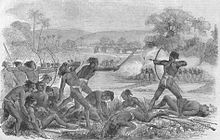
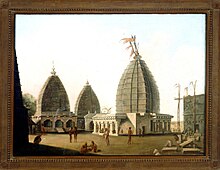


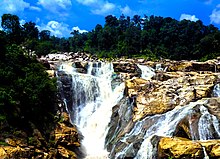





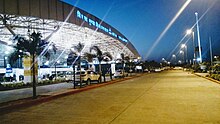






No comments:
Post a Comment